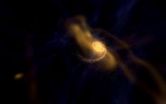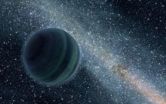Chemical engineers at Stevens invent portable hydrogen reactor for fuel cells
2011-05-23
(Press-News.org) Chemical Engineering students at Stevens Institute of Technology are transforming the way that American soldiers power their battery-operated devices by making a small change: a really small change. Capitalizing on the unique properties of microscale systems, the students have invented a microreactor that converts everyday fossil fuels like propane and butane into pure hydrogen for fuel cell batteries. These batteries are not only highly efficient, but also can be replenished with hydrogen again and again for years of resilient performance in the field.
With batteries consuming a substantial amount of a soldier's gear weight, the Army has a high interest in replacing the current paradigm of single-use batteries with a reliable, reusable power source. The Stevens-made microreactors thus have the potential to not only reduce waste from disposable batteries, but also provide American soldiers with a dependable way to recharge the batteries for the critical devices that keep them safe.
Current methods for generating fuel cell hydrogen are both sophisticated and risky, requiring high temperatures and a vacuum to produce the necessary chemical-reaction-causing plasmas. Once in a container, hydrogen is a highly volatile substance that is dangerous and expensive to transport.
The Stevens microreactor overcomes both of these barriers by using low temperatures and atmospheric pressure, and by producing hydrogen only as needed to avoid creating explosive targets in combat areas. These advanced reactors are created using cutting-edge microfabrication techniques, similar to those used to create plasma television screens, which use microscale physics to produce plasma under normal atmospheres.
The team has already had success producing hydrogen from methanol. After gasifying methanol by suspending it in hot nitrogen gas, the mixture is drawn into a 25µm channel in the microreactor. There, it reacts with plasma to cause thermal decomposition, breaking down the methanol into its elemental components. Now the team is conducting tests to see what kind of yields are realizable from various starter fuels. Eventually, soldiers will be able to convert everyday liquid fuels like propane or butane, commonly found on military bases, into high-potency juice for portable fuel cell batteries.
###
The team, made up of seniors Ali Acosta, Kyle Lazzaro, Randy Parrilla, and Andrew Robertson, are supporting Ph.D. candidate Peter Lindner in a research project sponsored by the U.S. Army. The project is overseen by Dr. Ronald Besser.
About the Department of Chemical Engineering and Materials Science
The mission of the Department of Chemical Engineering and Materials Science is to provide high-quality education and cutting-edge research training to students with strong disciplinary fundamentals and broad interdisciplinary and societal perspectives as adaptive experts and future leaders and innovators in their chosen profession. The programs offered by the Department produce broad-based graduates who are prepared for careers not only in traditional petrochemical, environmental, and specialty chemical industries, but also in such high technology areas as biochemical and biomedical engineering, electronic and semi-conductor processing, ceramics, plastics and high-performance materials, and electrochemical processing. Qualified undergraduates work with faculty on research projects, and many of graduates pursue advanced study in chemical engineering, bioengineering or biomedical engineering, medicine, law, and many other fields.
END
ELSE PRESS RELEASES FROM THIS DATE:
2011-05-23
A Biomedical Engineering Senior Design team at Stevens Institute of Technology is working with the U.S. Army and New Jersey physicians to develop a new device to combat hypothermia among wounded soldiers.
Team "Heat Wave" is composed of seniors Walter Galvez, Amanda Mendez, Geoffrey Ng, and Dalia Shendi, in addition to Biomedical Engineering graduate student Maia Hadidi. The team's faculty advisor is Dr. Vikki Hazelwood and consulting physician is Dr. Herman Morchel from Hackensack University Medical Center. Additional expert support from industry and military was provided ...
2011-05-23
Every year, the world consumes 15 Terrawatts of power. Since the amount of annual harvestable solar energy has been estimated at 50 Terrawatts, students at Stevens Institute of Technology are working on a supercapacitor that will allow us to harness more of this renewable energy through biochar electrodes for supercapacitors, resulting in a cleaner, greener planet.
Supercapacitors are common today in solar panels and hydrogen fuel cell car batteries, but the material they use to store energy, activated carbon, is unsustainable and expensive. Biochar, on the other hand, ...
2011-05-23
High-temperature superconductivity can be looked at as a fight for survival at the atomic scale. In an effort to reach that point where electrons pair up and resistance is reduced to zero, superconductivity must compete with numerous, seemingly rival phases of matter.
Understanding those phases and whether or not they are rivals or complementary phenomena has consumed the attention of theoreticians and experimentalists in the quest to find superconducting materials capable of functioning at close-to-room temperature, a potential that has gone unrealized for nearly three ...
2011-05-23
When taxpayers underreport income, whether intentionally or accidentally, the IRS always catches up. And when they do, they want to get paid - and now.
Sandra (Delevan, NY) found herself in just this predicament when she came into the Blue Tax offices with an IRS tax liability of $3,636 due to a 2006 tax return filed with underreported income. The goal of the team at Blue Tax was getting this client on a payment arrangement that accurately reflected her income, resolving all of this in a timely manner.
First, Blue Tax met with the client and submitted their personal ...
2011-05-23
Mummies from along the Nile are revealing how age-old irrigation techniques may have boosted the plague of schistosomiasis, a water-borne parasitic disease that infects an estimated 200 million people today.
An analysis of the mummies from Nubia, a former kingdom that was located in present-day Sudan, provides details for the first time about the prevalence of the disease across populations in ancient times, and how human alteration of the environment during that era may have contributed to its spread.
The American Journal of Physical Anthropology is publishing the ...
2011-05-23
Boston, MA - Charles J. Dimitroff, MS, PhD and colleagues in the Dimitroff Lab at Brigham and Women's Hospital, have developed a fluorinated analog of glucosamine, which, in a recent study, has been shown to block the synthesis of key carbohydrate structures linked to skin inflammation and cancer progression. These findings appear in the April 14, 2011, issue of the Journal of Biological Chemistry.
Dr. Dimitroff and colleagues show for the first time that the fluorinated glucosamine therapeutic works not through direct incorporation into growing sugar chains as previously ...
2011-05-23
CHAPEL HILL, N.C. – A team of researchers, including a number from the University of North Carolina at Chapel Hill School of Medicine, have pinpointed regions of the genome that contribute to the debilitating lung disease that is the hallmark of cystic fibrosis.
Their findings provide insight into the causes of the wide variation in lung disease severity experienced by CF patients. It also points the way to new diagnostic markers and therapeutic approaches for this and more common lung diseases such as COPD.
This study, which appears online Sunday, May 22, 2011 in ...
2011-05-23
Quit Tea, the natural stop smoking aid, has received an official professional endorsement. "This is a good product I will continue to tell my clients about," says Leeanne Taylor, a licensed drug and alcohol counselor with a private practice in Bangor, Maine, who specializes in smoking cessation.
Ms. Taylor received free samples of Quit Tea as part of the Quit Tea LLC's local Maine smoking cessation professional detailing program. She said "since that time I have given clients a tea bag and the website so they could get some of their own. The majority of ...
2011-05-23
How unique is the Milky Way?
To find out, a group of researchers led by Stanford University astrophysicist Risa Wechsler compared the Milky Way to similar galaxies and found that just four percent are like the galaxy Earth calls home.
"We are interested in how the Milky Way fits into the broader context of the universe", said Wechsler. "This research helps us understand whether our galaxy is typical or not, and may provide clues to its formation history."
The research team compared the Milky Way to similar galaxies in terms of luminosity--a measure of how much light ...
2011-05-23
Freelance writer Robert Brault offers a metaphor for the night sky, "A trillion asterisks and no explanations." By supporting astronomers, the National Science Foundation (NSF) helps to provide explanations. A recent NSF- and NASA-funded study provides one more explanation.
Astronomers have discovered a new population of Jupiter-size planets floating alone in the dark of space, away from the light of a star. According to the scientists, these lone worlds were probably ejected from developing planetary systems.
The discovery is based on a joint Japan-New Zealand survey, ...
LAST 30 PRESS RELEASES:
[Press-News.org] Chemical engineers at Stevens invent portable hydrogen reactor for fuel cells


